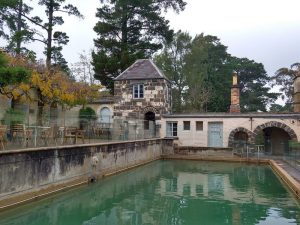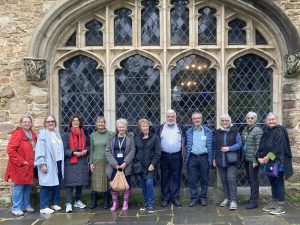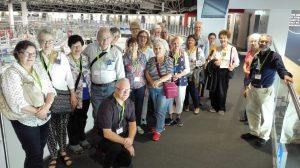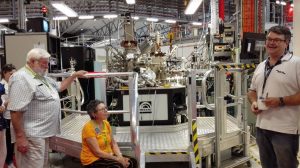Our guided tours
From time to time, we organise a guided tour around some notable, local location. Thanks to Cathy Romeo and Pam Griffith for organising. Here are the guided tours over the past few years.
From time to time, we organise a guided tour around some notable, local location. Thanks to Cathy Romeo and Pam Griffith for organising. Here are the guided tours over the past few years.
On 15th June, some of members were given a guided tour of Nillumbik Cemetery in Diamond Creek by Jean Verso from Nillumbik Historical Society and member of the Nillumbik Cemetery Trust.
The first recorded burial was Hannah Lawrey in 1869.
The gateway to the cemetery (Ellis Gateway) was installed in 1897 by the executor of the will of William Ellis at a cost of £100.
On 8th June, some of members were given a guided tour of Ellis Cottage in Diamond Creek by Jean Verso from Nillumbik Historical Society.
Ellis Cottage is historically significant for its association with the Ellis family, who were pioneers of the Diamond Creek district and the benefactors of the historic gateway at the Nillumbik Cemetery. It illustrates the development of farming in the area. Read more on the Nillumbik Historical Society website.

 On 13th May, some of members were lucky enough to be given a guided tour of Montsalvat by Vincent Galante.
On 13th May, some of members were lucky enough to be given a guided tour of Montsalvat by Vincent Galante.
Many of you will know that the 2019 mudbrick tour took place during October and was centred on St Andrews. What you won’t know unless you actually went on the tour is that the star of the show was the house of one of our members, Catherine Chambers.
Around 30 of us were lucky enough to be given a guided tour of Montsalvat by Vincent Galante. This was an event for our members only. To quote Lesley Wing Jan: “This was a wonderful experience – even for those who thought they knew all there is to know about Montsalvat. Vincent provided fascinating insights into lives of the founders, the history and construction of the buildings and the features of the gardens.” Thanks, Vincent!
Synchrotron, Monash and food – all good things in life (by Pam Jenkins).
 On Friday, 19th October, 21 intrepid adventurers travelled to the far reaches of Melbourne, well … Clayton, to inspect the Melbourne Synchrotron and the state of the art facilities at Monash University.
On Friday, 19th October, 21 intrepid adventurers travelled to the far reaches of Melbourne, well … Clayton, to inspect the Melbourne Synchrotron and the state of the art facilities at Monash University.
The day started with a little adventure for Rob, our wonderful bus driver, who had been supplied with 4 numbers of a 5-digit code to gain access to the bus. Luckily that problem was quickly resolved, and we were able to get away on time.
After signing in at the Synchrotron, there was no time for coffee as our presenter, Zoran Vasic, was there right on time to start our presentation. We gathered around a model of the Synchrotron where he gave us an explanation of what it is, what it does, and how it useful.
Simply put, the Synchrotron is a very large machine that speeds up electrons to almost the speed of light. As these electrons are deflected through magnetic fields, they create extremely bright light, one million times brighter than the sun. The various properties of the light are tuned to enable specific experiments to be performed utilising particular parts of the light spectrum. For example, when we were growing up we were told that most of the nutrients in our fruit and vegetables are held just under the skin; at the Synchrotron, we were shown a huge poster of a grain of barley graphically demonstrating that Mum and Dad were right … so we ordered whole meal baguettes for lunch.
We learned how scientists studying medicine, agriculture, mineral exploration, archaeology, animal conservation and art are among the many fields that have found that utilising the light source of the Synchrotron has sped up their research by weeks, months or even years.
 After an enjoyable lunch at the Taste Baguette at Monash, Karen Coulston introduced us to her friend Professor Andrea Robinson. Andrea guided us through the newer areas of Monash University. Learning isn’t the same as it was when I went to Uni (and that was only 20 years ago). Students are now clustered around large desk/workstations with interactive white boards projecting lecture notes, questions, diagrams and explanations for all to see overhead in the centre of the room and all around the walls. If you can’t make it to a lecture, you can find it online either in real time or some other time … and you can pause and replay! Outside the lecture halls, there is built-in sound attenuation so that even when crowded you don’t have to shout above an echoing hubbub of voices. The halls are beautifully designed with curved hanging brick work and a stairway that looks like it is going straight up to the gods. There are many alcoves for socialising and collaborative learning. A far cry from the ordinary library of my day.
After an enjoyable lunch at the Taste Baguette at Monash, Karen Coulston introduced us to her friend Professor Andrea Robinson. Andrea guided us through the newer areas of Monash University. Learning isn’t the same as it was when I went to Uni (and that was only 20 years ago). Students are now clustered around large desk/workstations with interactive white boards projecting lecture notes, questions, diagrams and explanations for all to see overhead in the centre of the room and all around the walls. If you can’t make it to a lecture, you can find it online either in real time or some other time … and you can pause and replay! Outside the lecture halls, there is built-in sound attenuation so that even when crowded you don’t have to shout above an echoing hubbub of voices. The halls are beautifully designed with curved hanging brick work and a stairway that looks like it is going straight up to the gods. There are many alcoves for socialising and collaborative learning. A far cry from the ordinary library of my day.
All in all, an awe inspiring day out.